SME Finance Policy Guide
SME Finance Policy Guide
SME Finance Policy Guide
Create successful ePaper yourself
Turn your PDF publications into a flip-book with our unique Google optimized e-Paper software.
G-20 <strong>SME</strong> FINANCE POLICY GUIDE<br />
49<br />
table 3. Financing per <strong>SME</strong>: Comparison Table<br />
Country<br />
Name of<br />
Program<br />
Starting<br />
year<br />
Financing Amount<br />
(USD m)<br />
Number of <strong>SME</strong>s<br />
outreached<br />
Financing per<br />
<strong>SME</strong> (USD)<br />
Afghanistan<br />
DEG - <strong>SME</strong><br />
Credit-Guarantee-Facility<br />
2005 37 1,256 29,459<br />
Brazil Programa INOVAR I-II 2001 1,000 3,250 307,692<br />
Canada<br />
Canada<br />
Chile<br />
EU<br />
Korea<br />
Turkey<br />
WB&G<br />
Business Development<br />
Bank of Canada<br />
Canada Small Business<br />
Financing Program<br />
FOGAPE (<strong>SME</strong> lending<br />
guarantee fund)<br />
EU/EBRD <strong>SME</strong> <strong>Finance</strong><br />
Facility<br />
The Korea Venture Capital<br />
Investment Corp<br />
European Investment Bank<br />
<strong>SME</strong> APEX Facility<br />
European-Palestinian Credit<br />
Guarantee Fund<br />
1944 15,008 28,000 536,000<br />
1999 8,000 113,850 70,268<br />
1980 9,636 362,753 26,564<br />
1999 3,168 101,000 31,366<br />
2005 1,100 930 1,182,796<br />
2005 216 343 629,738<br />
2005 43.2 1,200 36,000<br />
Source: Scaling-up <strong>SME</strong> access to financial services in the developing world, 2010<br />
capacity-building, etc.) should be carefully designed<br />
and better evaluated with a view to accurately measure<br />
their achievements in terms of outreach, additionality,<br />
and leverage. Subsidies should be only reserved to<br />
address actual market failures, and carefully designed to<br />
avoid any disincentive for private sector providers of<br />
financial services to serve the <strong>SME</strong> segment.<br />
Public procurement also represents a huge opportunity<br />
for <strong>SME</strong>s, and can be used to improve <strong>SME</strong> access to<br />
financial services, including supply chain finance. The<br />
value of public contracts awarded to <strong>SME</strong>s in a number<br />
of European countries during the recent global<br />
financial sector crisis was much larger than the value<br />
of guarantees provided to <strong>SME</strong>s.<br />
C.3.1: STATE BANKS<br />
State-owned banks have played an important role in<br />
<strong>SME</strong> finance in many developed and emerging countries<br />
as shown by two World Bank surveys, one conducted<br />
globally and the other focused on the MENA<br />
region. 55 Both surveys show that the share of <strong>SME</strong> loans<br />
in total loans is not significantly related to bank ownership,<br />
even after controlling for other factors. The<br />
survey conducted for the MENA region shows that<br />
55 Beck, Demirgüç-Kunt, and Martinez Peria. 2008. “Bank Financing for <strong>SME</strong>s around the World: Drivers, Obstacles, Business Models, and<br />
Lending Practices.” World Bank <strong>Policy</strong> Research Working Paper 4785. The World Bank, Washington DC. Rocha. Farazi. Khouri, and<br />
Pearce. 2011. “Bank Financing for <strong>SME</strong>s in the MENA Region: Evidence from a Joint Survey of the World Bank and the Union of Arab<br />
Banks.” <strong>Policy</strong> Research Working Paper 5607.March. The World Bank. Washington, DC.



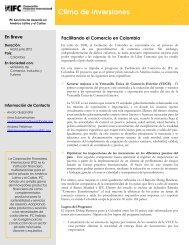
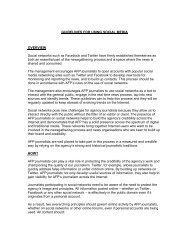
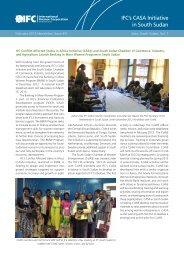

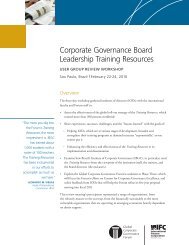




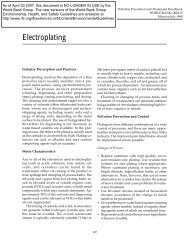
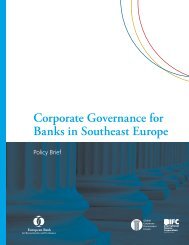
![Print a two-page fact sheet on this project [PDF] - IFC](https://img.yumpu.com/43449799/1/190x245/print-a-two-page-fact-sheet-on-this-project-pdf-ifc.jpg?quality=85)


